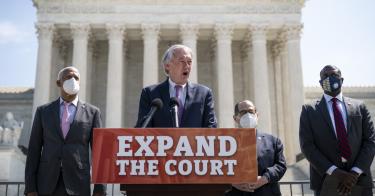If enacted, the Judiciary Act of 2021—which would add four seats to the Supreme Court—would be the most radical change to the Supreme Court as an institution in American history. One would, therefore, expect only the most compelling arguments from its backers. Judging from what we heard, however, this assault on judicial independence should crash and burn.
Senator Ed Markey (D., Mass.), for example, claimed that expanding the Supreme Court is necessary because “Republican appointees represent a 6-3 supermajority.” He made no attempt to explain why the number of justices appointed by presidents of different parties is relevant at all, nor did he explain why the 6-3 current tally is a problem.
>>> Left Is Using Supreme Court Commission to Change Court’s Decisions, Not to Improve It
In 1937, President Franklin Roosevelt proposed expanding the Supreme Court for the same reason Democrats want to do it today. He wanted some vacancies that he could quickly fill with justices who would rule the way he wanted. Though Democrats held an overwhelming 80–16 majority at the time, the Senate rejected Roosevelt’s plan by a vote of 70–20. More to Markey’s point, however, Democrats did so even though Republican appointees to the Supreme Court represented an even larger 7–2 “supermajority.”
Markey also argued that “Republicans have appointed 15 of the last 19” Supreme Court justices. He wants us to believe that presidents of each party appoint a group of judicial clones. Republican appointees in Markey’s group, however, include Harry Blackmun, who authored Roe v. Wade creating a right to abortion; John Paul Stevens, who has argued that the Second Amendment should be repealed; Anthony Kennedy, who authored Obergefell v. Hodges creating a right to same-sex marriage; and David Souter, who provided the deciding vote to reaffirm Roe.
Markey’s numbers correspond to the period since President Richard Nixon took office in 1969. But why slice and dice history that way? Looking a little further back to include Roosevelt, for example, the Republican-Democrat split is even at 20 apiece. The “Four Horsemen” who regularly voted to strike down Roosevelt’s New Deal legislation included James McReynolds, appointed by Democrat Woodrow Wilson, and the “Three Musketeers” who consistently supported the New Deal included Harlan Fiske Stone, appointed associate justice by Republican Calvin Coolidge.
Other Republican appointees included Chief Justice Earl Warren and Justice William Brennan, whose appointments President Dwight Eisenhower is said to have dubbed his worst mistakes while in office. Looking at how the justices do their job, instead of the party of the appointing president, puts a whole new spin on it.
Representative Jerrold Nadler (D., N.Y.), who chairs the House Judiciary Committee, fared no better. He claimed that the number of justices should be the same as the number of circuits on the U.S. Court of Appeals, like it was in the 19th century. Since there are 13 circuits today, Nadler said, there should be 13 justices. It’s hard to believe that Nadler doesn’t know why the number of circuits and justices was the same in the 19th century. A “circuit” court at that time was a trial court, and each justice presided over trial in their assigned circuit. They have not had that responsibility, however, for more than a century. In fact, the U.S. Court of Appeals we see today was created in 1891 with nine circuits. Even though Congress created four new circuits since then, the number of Supreme Court justices has remained the same. Today, there is no connection between the two.
>>> How “Court Packing” Would Damage Both the Judicial and Legislative Branches
Expanding the Supreme Court has nothing to do with its partisan balance at any given time, or some imaginary connection to the number of appeals court circuits. Nor is it connected to the Supreme Court’s capacity to do its work. Over the last decade, the Court heard arguments in an average of 76 cases per term and issued a written opinion in 65 of them. During the 1980s, however, arguments averaged 172 per term and opinions averaged 140. Unlike the lower courts, where a jurisdiction’s cases are divided among its judges, every Supreme Court justice handles every case that comes before the Court. Even if there were a workload problem, therefore, simply adding justices would do nothing to address it.
Democrats want to expand the Supreme Court for the same reason that Roosevelt did in 1937. They want a Court that reliably furthers their political agenda—and they want it now. Judicial independence includes the fact that most vacancies occur when judges decide to retire. Democrats today want the politicians to take over that responsibility as well. As the Senate Judiciary Committee report on FDR’s court-packing bill put it, however, it is “far better that we await orderly but inevitable change of personnel than that we impatiently overwhelm them with new members.”
Last year, Democrats called for honoring the wish of Justice Ruth Bader Ginsburg that she be replaced by the next president. This year, however, Democrats are ignoring Ginsburg’s wish that Congress refuse to expand the Supreme Court. Doing so would have the very consequence that Democrats avoided in 1937: the political takeover of the judiciary.
This piece originally appeared in The National Review




